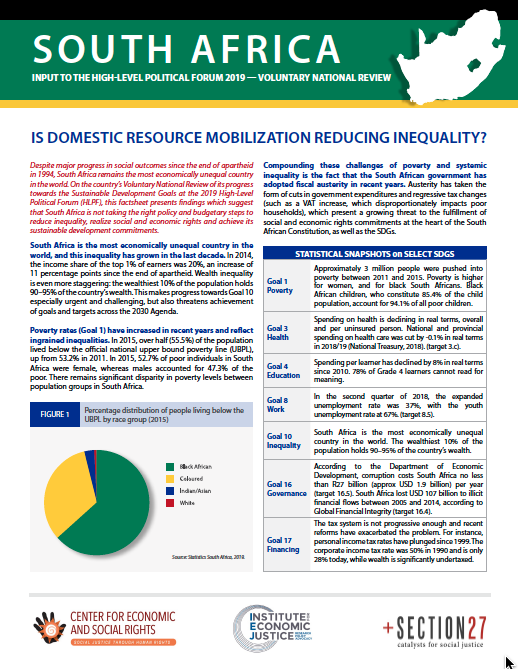July 16, 2019
As South Africa presents its Voluntary National Review (VNR) on progress towards the SDGs at the High-Level Political Forum (HLPF) in New York, a rights-based snapshot of obstacles and opportunities is put forward by CESR, the Institute for Economic Justice and Section 27.
 New York, July 16, 2019--Although major progress has been made in some areas, South Africa remains one of the most unequal countries in the world, with some dimensions of inequality actually worsening in recent years. The legacy of apartheid looms large. However, there is undoubtedly more that South Africa could be doing to fight inequality and progress towards all of the SDGs, especially with regards to domestic resource mobilization.
New York, July 16, 2019--Although major progress has been made in some areas, South Africa remains one of the most unequal countries in the world, with some dimensions of inequality actually worsening in recent years. The legacy of apartheid looms large. However, there is undoubtedly more that South Africa could be doing to fight inequality and progress towards all of the SDGs, especially with regards to domestic resource mobilization.A new HLPF factsheet by CESR, Institute for Economic Justice and Section 27 highlights some crucial areas where progress could be made across several SDGs, building on a shadow report made to the UN Committee on Economic, Social and Cultural Rights in 2018, and the Committee’s subsequent recommendations.
In particular, despite the government’s recognition in the VNR report that lack of funding is negatively affecting areas such as education and health, and that progressive taxation reforms are a necessary step, the government has in fact pursued a policy of austerity in recent years. This has included cutting expenditure in many key areas (such as health worker training and school infrastructure) and imposing regressive changes to the tax system (such as an increase in VAT rates, while the corporate income tax and tax rates for high earners remain low).
These alarming trends must be reversed if the country is to meaningfully tackle inequality and move towards achievement of the 2030 Agenda, as well as fulfillment of the laudable social and economic rights commitments at the heart of the South African constitution.
As the government’s VNR report recognizes, “Resources needed to achieve the SDGs are within reach,” including through tackling corruption and illicit financial flows and expanding resource mobilization. This brief factsheet identifies some key areas where urgent improvement is needed.
This factsheet is part of CESR’s strategy to bring recommendations from human rights mechanisms to the HLPF, in an effort to address the disconnect between human rights and sustainable development at the UN level, as well as the deficits of the HLPF as a forum for accountability. By connecting our global advocacy with robust national-level research conducted with our partners, we are bringing a much-needed human rights analysis into the SDG monitoring apparatus.